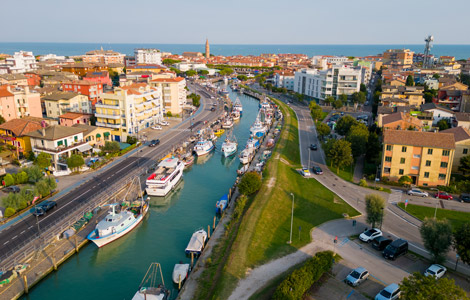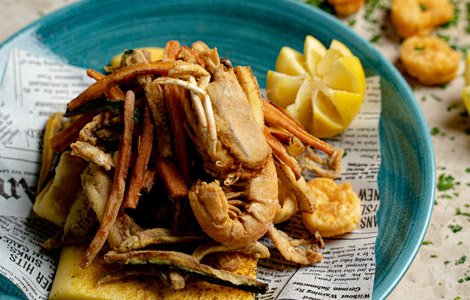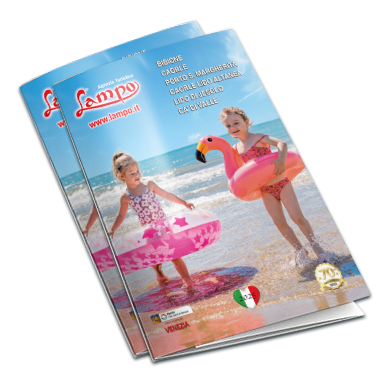Caorle is a seaside town that’s hugely popular with people from Italy and across the globe. Every year, they flock to spend their holidays there, exploring the narrow streets and little squares in the historic centre. In some respects, the multi-coloured houses call to mind the famous island of Burano.
Caorle is on the Veneto coast, between the wild Brussa beach and the expanses of sand in Eraclea Mare. Moving from East to West, the names of Caorle’s beaches are Levante, “Dea Sacheta” (or Della Madonnina), Ponente, Porto Santa Margherita, Lido Altanea and finally Duna Verde.
Caorle is approximately 66 kilometres from Venice and it takes about an hour to drive there.
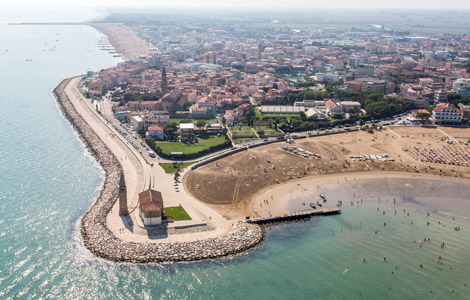
Caorle’s origins
Caorle is one of the most popular tourist destinations on the Northern Adriatic coast. If you’d like to book a holiday there, we recommend that you visit our website or contact us. We’ll be happy to answer all your questions and handle any requests you might have. But what’s the story behind the origins of the town?
Various theories have been put forward about where the name Caorle comes from. The roots of the town seem to stretch back to Roman times, when there was a port called Reatinium where Porto Falconera can be found today. Ships moored there and passed through before heading up the Lemene River to the towns of Opitergium (now known as Oderzo) and Julia Concordia (now called Concordia Sagittaria).
The town was once called “Caprulae” and it’s thought that the name came from a forest where wild goats grazed in ancient times. However, there are two alternative theories about the origins of the name: one is that it comes from worship of the pagan goddess “Capris” and the other is that it’s a reference to the shape of the land, which is vaguely reminiscent of a goat’s horns.
The founding and ancient history of Caorle
Although Caorle developed under the Romans, the first people actually settled there in prehistoric times. The remains of homes found in the countryside in the San Gaetano area could date back to as long ago as 1,500 years before Christ.
Nonetheless, the first really significant settlement took shape in Roman times, when Caorle grew in importance thanks to the shipping passing through Porto Falconera. A Roman ship from the first century AD – which still contains a considerable number of amphorae – has been discovered off the coast.
The Middle Ages and the Venetian influence on Caorle
Caorle seemed destined to lose its prestige after the fall of the Roman Empire, but it held onto its importance because the Barbarian invasions forced many people to flee from the mainland towards the sea, the lagoon and the islands.
Over time, the influx of these people led to the birth of Venice and development of the smaller settlement of Caorle, which gained prominence due to both the significant increase in its population and booming trade with Venice thanks to its strategic location. Churches and a bishop’s residence were built due to its fame and high status.
The town experienced a reasonably long period of extensive growth, although it was punctuated by wars such as the conflict between Genoa and Venice in 1378, which left Caorle on its knees.
Subsequently, the town suffered the same fate as Venice. It too experienced a period of decline and subsequently came under the rule of Napoleonic France and subsequently the Habsburg Empire.
Contemporary history in Caorle
Caorle endured. The two World Wars inevitably tore lives apart and filled the town with ruins and destitution, but the people were determined to recover.
While fishing and hunting continued to be key ways for the people of Caorle to make a living, in the decades after the Second World War they also capitalized on the growing phenomenon of mass tourism, which stemmed from fresh developments such as increases in disposable income, paid holidays and urbanization.
The changes didn’t take place overnight. The first land reclamation schemes in the early 20th century were followed by an almost pioneering stage of tourism. The first hotel was the Albergo Petronia, which was built in 1911. It was not until the opening of the first beach establishment in around 1920 that the local people began to play a more active role in the tourism industry that was gradually developing. Tourism finally became more established in the 1980s, a time that saw growth in hotels, holiday home rentals and other types of services.
As well as significantly altering the appearance of the urban area, the developments transformed the economy. Nevertheless, the people of Caorle have managed to preserve their fascinating age-old traditions. In addition, fishing still makes a substantial contribution to the economy, as well as bringing superior seafood to the tables of trattorias, restaurants and hotels every day.
Local traditions in Caorle
No other Northern Adriatic resort is quite like Caorle, thanks to the way in which it’s preserved the appeal of its picturesque historic centre and its folk, food and wine traditions, while also providing a home for thriving, modern new facilities, beach establishments and state-of-the-art services. What makes Caorle so special? Its history and its natural and cultural heritage, which is also where the roots of its age-old traditions can be found.
Festivals and cultural events in Caorle
Every year, countless events are organized not only to delight the numerous tourists visiting Caorle, but also to reflect the religious beliefs and folk traditions of the local people, who feel more actively involved in the life of the community thanks to these initiatives.
Various events are organized, including:
- The traditional “Procession of Our Lady in the Sea”, which takes place once every five years in the second week of September. A fishing boat parade accompanies the statue of the Madonna on a route through the town centre and the fishing harbour, then over to the seafront Sanctuary by the coastal defences. If you’d like to know more, take a look here.
- “Burning the Bell Tower” is an event that takes place in Caorle on the second Saturday and the second Sunday of July every year. Red lights shine and smoke is released inside the cathedral bell tower in front of huge crowds of devotees and other onlookers. They follow the effigy of the Madonna from the Sanctuary to the Cathedral, then go down the same route again the opposite way the next day, when the statue is taken back to the little church by the sea. You can find more details here.
- For a number of years, the “La Luna nel Pozzo” festival for street artists has brought jugglers, tightrope walkers, actors and clowns to Caorle in September. The crescendo of suspense during the fun, mind-blowing shows will have you watching with bated breath from the first to the last minute. The magical atmosphere appeals to young and old alike.
- For many years, traditional Caorle cuisine has been served on September weekends on “Dea Sacheta” beach near the Sanctuary of the Madonna dell’Angelo, during the “Fish Festival”. Fishers cook their catches on big grills on the beach. Sitting on benches by the shore, everyone can savour the delights of freshly caught fish. A number of “casoni” (traditional fishermen’s homes with thatched roofs) are built on the beach, making the atmosphere at the event even more enchanting.
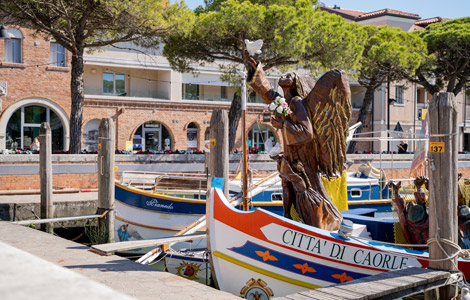
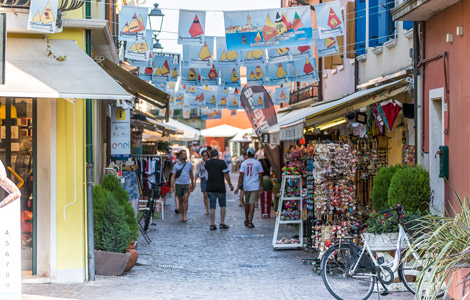
Plenty of people also go to Caorle during the winter,when you can take pleasant, relaxing strolls through the narrow streets in the historic centre and stop off in a pastry shop to sip a hot chocolate. Alternatively, you could go for a stroll on the seafront and take beautiful photos as the day comes to an end, because there’s nothing quite like the sight of the sunset over the sea.
Various events are organized in Caorle at different times during the winter:
- Caorle Wonderland brings a magical Christmas atmosphere to the historic centre, filling the streets with stalls selling artisanal wares, food trucks and attractions such as an ice rink and cabins where kids can meet Santa Claus and Befana, a kind old crone who gives gifts to children on Epiphany Eve. You can also enjoy an entrancing ride on a Ferris wheel dotted with countless lights and look down on the town from on high!
- Caorle in Maschera is the name of the carnival celebration that normally takes place in February. As well as a host of elaborate, colourful floats, there are shows, plays, a procession featuring historical Venetian masks, a parade for children in fancy dress and a carnival lottery draw to bring the curtain down on it all, not to mention food and wine stands and food trucks at the weekends.
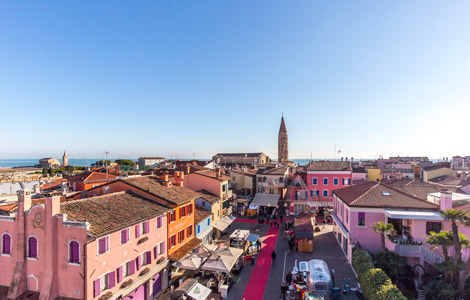
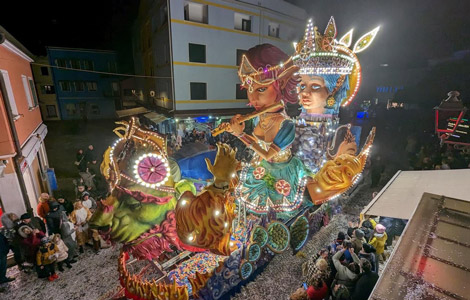
Art, craft and food traditions in Caorle
Painting and cuisine are two of the endless ways in which Caorle beguiles tourists.
- The historic centre has always been bursting with kaleidoscopic colours, but things have reached a whole new level in recent years thanks to the large numbers of “street artists” who’ve been invited by the town council to use it as an open-air canvas. On the walls of buildings dotted throughout Caorle, they’ve used their creative talents to convey all sorts of different feelings, ideas and visions for the future. In some cases, they’ve used their skills in peaceful protests that harness the beauty of art. Take a stroll through the streets and you’ll soon come across the captivating murals, some of which cover whole sides of buildings. Two more large murals can be found in Lido Altanea: there’s one at the entrance to the Acacie village and one at the Happy Arena, where the entertainment team put on shows in the evenings. There are also two smaller murals: one in another part of the Acacie village and one at the Agenzia Lampo offices.
- The magic of the colourful homes in Caorle is recreated in the works of Romina Raimondo, who grew up and left a piece of her heart there. She uses acrylic paint on canvas with a very minimalist touch, choosing bright colours that really breathe life into her striking, spellbinding depictions of the town.
There’s no doubt that in many people’s eyes Caorle and great food go hand in hand.
Numerous restaurants, trattorias, pizzerias, ice cream parlours and pastry shops purvey pleasures of the palate for locals, tourists and visitors from the surrounding area who love to take trips to Caorle in order to savour traditional Veneto dishes and choice recipes featuring freshly caught fish.
A vast array of traditional Caorle dishes have been passed down from one generation to the next. We’d like to recommend a few that you simply have to try if you go there on holiday:
- Sarde in saor – marinated sardines in onions, with raisins, vinegar and pine kernels.
- Broeto de sepe – finely chopped cuttlefish cooked in white wine and tomato sauce, served with slices of polenta or toast.
- Spaghetti alle vongole – shelled clams that are pan fried with garlic, oil and white wine, served with spaghetti cooked with the pan juices from the clams.
- Moscardini in umido – moscardini (musky octopuses) cooked in a saucepan with garlic, oil, chilli peppers and white wine, served with wonderfully soft polenta.
- Bigoi in salsa – long, thick strands of pasta served with onions and sardines.
- Risotto con canestrelli – rice cooked in vegetable stock with butter and Grana Padano cheese, served with queen scallops browned in garlic, oil and parsley.
To go with these culinary delights, we recommend the outstanding wines from the inland areas of Veneto or the Friulian hills, such as Pinot Bianco, Pinot Nero, Raboso and Verduzzo.
If you’d like to book a holiday in Caorle, take a look at our website, where you’ll find constantly updated details of accommodation that’s available in the resort.
If you’d like any other information, contact us and we’ll be happy to help. Finally, in the Veneto area you can also visit lots of other charming towns and villages with a wealth of art, history and traditions, such as Portogruaro and Concordia Sagittaria, which are only about half an hour away by car. Take a look at our blog to find out more.
